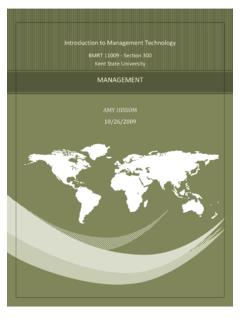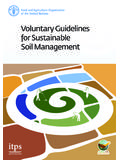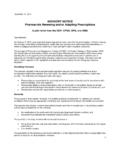Transcription of Adapting to climate change through land and water ...
1 Adapting to climate change through land and water management in Eastern Africa Results of pilot projects in Ethiopia, Kenya and Tanzania Adapting to climate change through land and water management in Eastern Africa Results of pilot projects in Ethiopia, Kenya and Tanzania FOOD AND AGRICULTURE ORGANIZATION OF THE UNITED NATIONS. Rome, 2014. The designations employed and the presentation of material in this information product do not imply the expression of any opinion whatsoever on the part of the Food and Agriculture Organization of the United Nations (FAO) concerning the legal or development status of any country, territory, city or area or of its authorities, or concerning the delimitation of its frontiers or boundaries.
2 The mention of specific companies or products of manufacturers, whether or not these have been patented, does not imply that these have been endorsed or recommended by FAO in preference to others of a similar nature that are not mentioned. The views expressed in this information product are those of the author(s) and do not necessarily reflect the views or policies of FAO. ISBN 978-92-5-108354-3 (print). E-ISBN 978-92-5-108355-0 (PDF). FAO, 2014. FAO encourages the use, reproduction and dissemination of material in this information product. Except where otherwise indicated, material may be copied, downloaded and printed for private study, research and teaching purposes, or for use in non-commercial products or services, provided that appropriate acknowledgement of FAO as the source and copyright holder is given and that FAO's endorsement of users' views, products or services is not implied in any way.
3 All requests for translation and adaptation rights, and for resale and other commercial use rights should be made via or addressed to FAO information products are available on the FAO website ( ). and can be purchased through III. Contents Foreword VI. Acknowledgements VII. List of Acronyms and Abbreviations IX. Summary XI. Introduction 1. Part 1: Project Findings 13. A Planning Framework for Adaptation at the Local Level 13. Pillar 1: Increasing Soil Health 14. Pillar 2: water Conservation 21. Pillar 3: Livelihood Diversification 26. Pillar 4: Strengthening Local Institutions 30. Lessons Learned 33. Scaling-Up 39. References 43.
4 Part 2: Country Case Studies 47. Ethiopia Background: Community-based, participatory integrated watershed 48. management as an approach to climate change adaptation in Haro Jila and Wurba watersheds Paper 1: Improving adaptive capacities of farmers through rainwater 63. harvesting in Wurba watershed, Shoa Robit Woreda, Ethiopia IV. Paper 2: Protecting farm land and homestead areas from unpredictable 70. floods: a case study on the experience of smallholder farmers, Haro Jila watershed, Sebeta Woreda, Ethiopia Kenya Background: Strengthening capacity for climate change adaptation in 76. sustainable land and water management : diversifying farmers'.
5 Livelihoods in Siaya and Machakos Counties, Kenya Paper 1: Enhancing seed and food security and cash income 83. for vulnerable farmers of Siaya County, Kenya Paper 2: Marketable banana production for enhanced 91. incomes and food security, Siaya County, Kenya Paper 3: Fish farming for food and income 100. diversity in Siaya County, Kenya Paper 4: More land for food production from reclaimed 107. gullies in Mwala, Machakos County in Eastern Kenya Paper 5: Coping with insufficient rainfall through drought 111. tolerant crops in the drylands of Machakos, Kenya Tanzania Background: Strengthening the capacity for climate change adaptation 117.
6 through sustainable land and water management in Kiroka village, Morogoro, Tanzania Paper 1: The system of rice intensification to maximise paddy yields 134. using improved water management , Kiroka village, Morogoro, Tanzania Paper 2: Assisting smallholder farmers to adapt to the effects of climate 140. change through soil and water conservation, Kiroka village, Morogoro, Tanzania Paper 3: Cost saving ($410 /household/year) and reducing deforestation 148. through energy saving stoves, Kiroka village, Morogoro, Tanzania V. Paper 4: Beekeeping as an incentive for participatory forestry, land and 155. water management in the highland areas of Kiroka village, Morogoro, Tanzania Paper 5: Changing the mind-set of Kiroka farmers towards adoption of 159.
7 climate smart agricultural innovations through capacity building . a Summary Glossary 163. VI. Foreword climate change and variability is a major challenge facing smallholder farmers and adaptation is now a priority in many countries of sub-Saharan Africa. Farmers, livestock keepers, and fisher-folk living in fragile environments such as drylands and mountain areas are directly exposed to the risks associated with climate change . This is particularly true in regions that already suffer from soil degradation, water scar- city and high exposure to climatic extremes, and where poverty and hunger persist. FAO assists its member states in managing ecological, social and economic risks associated with agricultural sector production systems, and supports climate change adaptation in many countries.
8 It focuses its attention on the vulnerable with few assets other than their labour and some land , who rely on farming to produce food for themselves and their families, and to secure their livelihoods. This publication presents the findings of a project funded by the Swedish Interna- tional Development Agency, aimed at strengthening the capacity of farmers to adapt to climate change through land and water management among rural communities in three countries of Eastern Africa- Ethiopia, Kenya and Tanzania. It focuses on the household level, where most adaptation and coping strategies are implemented. It stresses the importance of investing in better soil health and conservation of water , shows how income diversification contributes to enhanced resilience among local populations, and highlights the importance of strong local institutions and community-based organization in support to climate change adaptation.
9 Strengthening technical and institutional capacity and building resilience to climate change leads to a reduction in the exposure and sensitivity to climate risk. I trust that the lessons learned from practices tested on the ground in this project can provide insights and contribute to designing effective climate change adaptation programmes in sub-Saharan Africa and beyond. Maria Helena Semedo Deputy Director-General Coordinator for Natural Resources VII. Acknowledgements This report presents the results of a pilot project funded by the Swedish Interna- tional Development Cooperation Agency (Sida) and implemented by FAO, aimed at building resilience to climate change among smallholder farmers in Ethiopia, Kenya and Tanzania.
10 The project adopted a highly decentralised approach, relying on a team of experts, technicians and field operators in each country, while also promoting interactions and exchanges between teams. At FAO, the project was implemented by a multidisciplinary team led by Alemneh Dejene, Jean-Marc Faur s, Sally Bunning and Meshack Malo, with support from Janie Rioux, Domitille Vall e, Julia Seitz and Liliane Kambirigi. Project implementa- tion in the three pilot countries was coordinated by Meshack Malo. In Ethiopia, pilot activities were coordinated by Getachew Debalkie with assis- tance from Brook Solomon. Staff involved in the two pilot sites included Chala Adere, Elias Kediro, Dingade Adungna, Hailu Adugna, Kebede Bayecha, Betiglu Abebe, Mintwab Shiferaw, Abiyot Hiwot, Adane Bekele, Ararsa Abate (for Haro Jila watershed), and Habtweld Tege, Moges Girma, Shambel Sharew, Solomon Tadesse, Tadesse Balhyider, Endalkachew Yeshigeta, Zewdu G/Yesus, Tenaye Akalu, Tilahun Wube, Woldamanuel Delelegne (for Wurba watershed).

















